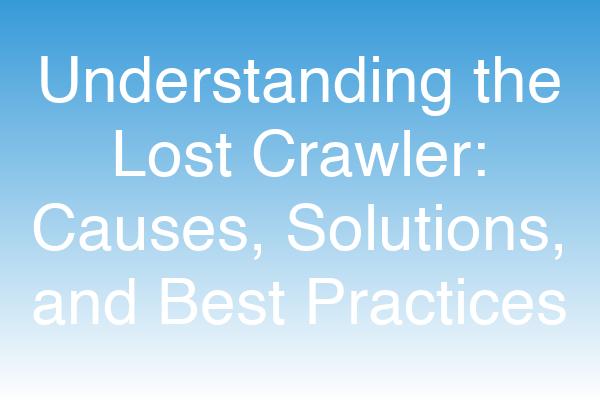
Categories: SEO, Digital Marketing, Website Management
Tags: lost crawler, SEO issues, website indexing, search engine optimization, web crawlers, site visibility
Understanding the Lost Crawler: Causes, Solutions, and Best Practices
In the ever-evolving world of digital marketing, understanding the intricacies of search engine optimization (SEO) is crucial for maintaining your website's visibility. One significant issue that many website owners encounter is the phenomenon known as a "lost crawler." In this comprehensive guide, we will delve into what a lost crawler is, the common causes behind it, and actionable solutions to ensure your website remains indexed and visible to search engines.
What is a Lost Crawler?
A lost crawler refers to a situation where a search engine bot, or crawler, is unable to access or index certain pages of a website. This can lead to reduced visibility in search engine results, ultimately affecting traffic and conversions. Understanding the causes of lost crawlers is essential for any website owner or digital marketer looking to optimize their online presence.
Common Causes of Lost Crawlers
Robots.txt Misconfigurations
- Incorrect settings in your robots.txt file can inadvertently block crawlers from accessing important pages.
Broken Links
- Internal or external links that lead to 404 errors can prevent crawlers from navigating your site effectively.
Server Issues
- Downtime or slow server response times can hinder crawlers from accessing your website.
Poor Site Structure
- A complicated or unclear site structure can confuse crawlers, making it difficult for them to index your pages.
Redirect Chains
- Multiple redirects can slow down the crawling process, leading to lost crawlers.
How to Diagnose a Lost Crawler Issue
To effectively address lost crawler issues, it’s crucial to diagnose the problem accurately. Here are some steps to help you identify if your site is experiencing this issue:
Check Google Search Console
- Use the Coverage report to identify pages that are not indexed and the reasons behind it.
Run a Site Audit
- Utilize tools like Screaming Frog or SEMrush to analyze your website for broken links, crawl errors, and other SEO issues.
Review Server Logs
- Analyze server logs to see how often crawlers are visiting your site and if they are encountering any errors.
Solutions to Prevent Lost Crawlers
1. Optimize Your Robots.txt File
Ensure that your robots.txt file is correctly configured to allow crawlers to access important pages. You can test your robots.txt file using Google’s Robots Testing Tool.
2. Fix Broken Links
Regularly audit your site for broken links and fix them promptly. Tools like Ahrefs or Broken Link Checker can help identify these issues.
3. Improve Server Performance
Consider upgrading your hosting plan or optimizing your server settings to ensure faster response times and minimal downtime.
4. Simplify Site Structure
Create a clear and logical site structure that makes it easy for crawlers to navigate. Use breadcrumb navigation and a well-organized sitemap.
5. Minimize Redirects
Limit the number of redirects on your site to improve crawl efficiency. Use 301 redirects for permanent changes and avoid redirect chains.
Expert Insights
"Understanding how crawlers interact with your site is crucial for SEO success. Regular audits and proactive measures can prevent lost crawlers and ensure your content is indexed." - Jane Doe, SEO Specialist
"A well-structured website not only enhances user experience but also ensures that search engine bots can efficiently crawl and index your pages." - John Smith, Digital Marketing Expert
Table: Common Causes and Solutions for Lost Crawlers
| Cause | Solution |
|---|---|
| Robots.txt Misconfigurations | Optimize robots.txt file |
| Broken Links | Regularly audit and fix broken links |
| Server Issues | Improve server performance |
| Poor Site Structure | Simplify site structure |
| Redirect Chains | Minimize redirects |
Best Practices for Ongoing SEO Health
- Regularly Update Content: Fresh content keeps your site relevant and encourages crawlers to visit more frequently.
- Monitor Site Performance: Use tools like Google PageSpeed Insights to ensure your site loads quickly.
- Engage in Link Building: Quality backlinks can enhance your site's authority and visibility.
Conclusion
In conclusion, understanding and addressing the lost crawler phenomenon is vital for maintaining your website's visibility in search engine results. By implementing the solutions and best practices outlined in this guide, you can ensure that your site remains accessible to crawlers, ultimately driving more traffic and conversions.
Call-to-Action: Are you experiencing issues with lost crawlers on your site? Contact us today for a comprehensive SEO audit and tailored solutions to enhance your website's performance!
Social Media Snippet: 🚀 Is your website facing lost crawler issues? Discover the causes and solutions to keep your site indexed and visible in search results! #SEOTips #LostCrawler
Suggested Internal Links:
- SEO Best Practices for 2023
- How to Use Google Search Console Effectively
- The Importance of Site Structure in SEO
Suggested External Links:
FAQs
Q1: What is a crawler in SEO?
A crawler is a bot used by search engines to index web pages and gather information about them.
Q2: How can I check if my site has lost crawlers?
You can use Google Search Console to check for indexing issues and crawl errors.
Q3: What are the effects of lost crawlers on my website?
Lost crawlers can lead to reduced visibility in search results, resulting in decreased traffic and potential revenue loss.
Q4: How often should I audit my website for SEO issues?
Regular audits every 3-6 months are recommended, or more frequently if you update your content often.
Q5: Can I fix lost crawler issues myself?
Yes, many lost crawler issues can be resolved with the right tools and knowledge, but consulting an SEO expert can provide additional insights.
By following these guidelines and implementing the strategies discussed, you can enhance your website's SEO performance and ensure that lost crawlers are a thing of the past.